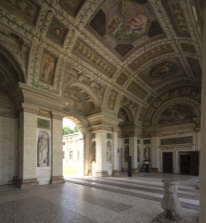
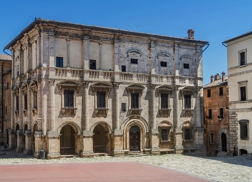
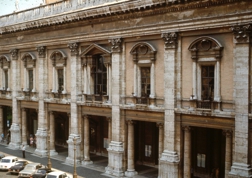
During the twentieth century, and certainly now in the twenty-first century, the explicit presence of a skeletalized or gridded structure has been a prominent architectural theme; and, as one surveys Italian sixteenth century architecture, one may also become conscious of a gridding, webbing, strapping, lacing, framing of both surface and space.
Instances of such effects, both surface and spatial, are more than abundant in the repertory of so-called Mannerist architecture; but, in the scope of this brief essay, their activity can scarcely be discussed in any detail.1 However, to cite an effect of surface, one might consider the aggressively gridded facades of Michelangelo’s Capitoline palazzi (Figure 1); and, to cite a similar effect of space, one might introduce Giulio Romano’s loggia at the Palazzo Te (Figure 2). Then, with so much noticed, it might be rewarding to compare the Capitoline facades with such an earlier building as the Palazzo Tarugi (Figure 3) at Montepulciano and Giulio’s loggia with its precursor, the loggia of the Villa Madama (Figure 4). For both comparisons tend to sustain approximately the same generalizations; and thus, with Michelangelo and Giulio, there is a tendency to suppress protuberance in favor of flatness, arcuation in favor of trabeation, the rotund in favor of the angular; while, in each case, it is apparent that a species of gridding has insinuated itself as a primary ordering device.
But to turn now from architecture to painting: some form of gridded structure, whether assertive or subdued, is no doubt a universal component of building; and it is not so clear that the presence of gridding has ever been so decisive a component of painting. Nevertheless, in much twentieth century painting the presence of gridding, both rectilinear and diagonal, has played a highly significant role; and, thus one may think of the compounded grids of analytical Cubism and the more-directly gridded products of, say, Léger and Mondrian (Figures 5a, 5b).
Figure 1: Michelangelo, Palazzo dei Conservatori, Piazza del Campidoglio, begun 1563, Rome
Figure 2: Giulio Romano, Palazzo Te, Garden Loggia begun 1525, Mantua
Figure 3: Antonio da Sangallo the Elder, Palazzo Tarugi, ca 1530, Montepulciano
Page 1
16th Century: Jacopo Vignola, Palazzo del Municipio, 1572, Velletri
20th Century: Giuseppe Terragni, Casa del Fascio, 1936, Como
The Activity of the Modernist Grid in Sixteenth Century Italy
Judith DiMaio
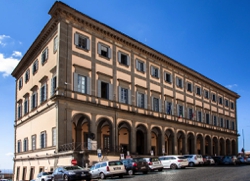
Introductory images
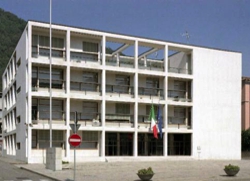
Note:
See page 5 for Notes and Image credits
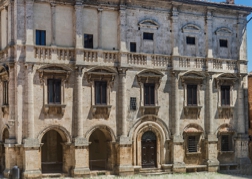
Click monogram to return to home page